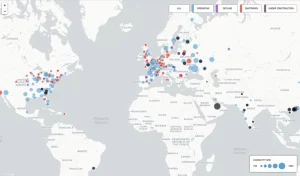James Cooper revisits resource nationalisation, where governments assert control over natural wealth. From bold seizures to subtle tax hikes, discover how this trend impacts investors and why you should be alert.
Resource nationalisation is a topic I keep coming back to; it’s popping up everywhere these days. But what exactly is it?
At its most extreme, it involves the forceful takeover of a mine, usually by a military ‘junta-like’ government.
Turfing out the multinational that spent millions developing the project.
Sometimes, this happens without warning, like the Frontier Mine in the Democratic Republic of Congo.
Formerly owned by the Canadian producer First Quantum, the DRC government sent its military to take control of the mine in 2010.
At the time, it was the largest copper mine in the country.
But sometimes resource nationalisation takes on a ‘slow death’ for the multinational… Where the host government gradually erodes the company’s will to operate, leaving them no choice but to abandon their asset.
That’s what’s happening with Barrick’s Loulo-Gounkoto mine in Mali, a gold project under care and maintenance since local officials threatened to arrest Barrick executives, seized the company’s bullion, and demanded punitive royalties.
This operation has become unviable for Barrick to continue.
Yet, resource nationalisation is often far more subtle…
Like higher royalties or compulsory purchases, giving the state more control over its natural resources.
But whatever form it takes, operators hate the word nationalisation and are ready to stamp out any sign of it as soon as it emerges!
Which is why this article from the local newspaper, Kalgoorlie Miner, caught my attention last week…
According to the piece, the Shire of Coolgardie in WA’s Eastern Goldfields proposed increasing its local mining tax to boost finances by around $8.7 million annually.
Advertisement:
WATCH NOW: Australia’s ‘abandoned gold’
A revolution is taking place in Australia’s mining sector.
A new type of miner is bringing old gold and critical minerals back to life…and already sending some stocks soaring.
Our in-house mining expert — a former industry geologist — has tapped his industry contacts to uncover four of these stocks that could be next…
Click here to watch now.
That decision has stirred an uproar among the local mining operators!
Multi-billion-dollar giants like Gold Fields, which owns the St Ives mine south of Kambalda, and Evolution Mining, Australia’s second-largest gold miner, have staunchly opposed the hike.
So have some other big hitters like Andrew Forrest’s backed Wyloo Metals, Chris Ellison-led Mineral Resources, and Tim Goyder’s Minerals 260.
So, why are these bigwigs in such a stir over what is a relatively trivial cash-grab by the local shire?
Mining Memo’s Take
No matter what form it takes, operators will do everything they can to prevent higher royalties, taxes, or anything else that smells like resource nationalisation!
You could argue that the Shire is well within its rights here, given the increased pressure on its roads and other local infrastructure caused by the ramp-up at these mining projects.
Yet, these major mining outfits will do everything possible to stamp out these ‘spot fires’ or risk having other jurisdictions implement something similar.
But in terms of investors, the key thing to note here is that resource nationalisation is heating up, virtually everywhere.
That’s why I keep coming back to this critical point… Whether it’s a military junta looking to grab hold of a mine or just the local Shire looking to add more cash to its coffers…
Resource nationalisation (in all its forms) rises when the commodity cycle turns upward. And there are signs of it everywhere right now.
Stay tuned.
Regards,
 |
James Cooper,
Editor, Mining: Phase One and Diggers and Drillers

All advice is general advice and has not taken into account your personal circumstances.
Please seek independent financial advice regarding your own situation, or if in doubt about the suitability of an investment.

James Cooper has been a working geologist in mines across Australia, Canada, and Africa since the early 2000s. He’s led the operations of tiny explorers through to huge producer outfits. He’s seen booms and busts firsthand and he also understands the cyclical nature of individual commodities. For example, James was right there when Barrick Gold launched an enormous $7.5 billion takeover bid for Equinox. That was the peak of the last cycle.
With his background as a geo and finance professional, he brings a unique insight and experience to Fat Tail Investment Research. He writes the broader resource-focused investing letter Diggers and Drillers and the ultra-speculative explorer-focused trading service Mining: Phase One.



